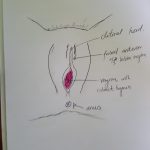Case 2:
Female infant aged 5 weeks 5days brought by mum for distended abdomen and fever. This is an infant born of a moderately well followed up pregnancy. Delivery went on well and immediate post-delivery care was done. At about 3 weeks of life, mum noticed yellow eyes for which she consulted in a nearby health center and was told it would clear up by itself. No lab test was done. Almost 2 weeks later, parents noticed distended abdomen for which they still resorted to a nearby private clinic and syrup for colics prescribed. The persistence of abdominal distension and onset of fever few days later led to this consultation.
On clinical exam, hematemesis, and whitish stool.
Ill-looking with very yellow sclerae and pale conjunctivae, palms and feet.
Fever, tachypnea.
Distended abdomen with collateral veins, hacket 2 splenomegaly, dullness on percussion and normal bowel sounds.
Diagnosis: Late bacterial neonatal infection on biliary atresia complicated with portal hypertension and anemia.
Conjugated Bilirubin level was elevated and abdominal ultrasound was in favour of diagnosis. Blood transfusion was done, and the infant was oxygen-dependent. Prognosis was predicted as poor. Rescucitation was done on 3 occasions prior to surgery. Baby survived surgery and was lastly seen at 4 months follow-up.
Case 3:
A 3 weeks 3days old neonate brought by mum for fever since few days. History reveals moderately well followed-up pregnancy with no complications at delivery. Mum noticed yellow eyes at about 2 weeks of life and was advised in a health center to observe. No work-up was done. This later became associated to fever leading mum to directly come to the reference health facility, with baby, for consultation.
On clinical exam, icteric sclerae, palmoplantar palour and fever. Mildly distended abdomen, no mass palpable, normal percussion and bowel sounds.
Diagnosis was late bacterial neonatal infection on a probable biliary atresia, while considering the possibility it could rather be a late bacterial infection manifesting with jaundice with high free bilirubin. Work-ups requested showed high conjugated bilirubin and severe anemia. Abdominal ultrasound was in favour of biliary atresia.
Transfusion was done and surgeons were contacted. Baby was transferred elsewhere on mother’s request by 4th week of life for surgery.
Key Points:
Biliary atresia manifests in the neonatal to infant period and usually has a good prognosis when treated within first 6 weeks (other sources:<2 months) of life. The treatment is SURGICAL (Kasai portoenterostomy). You could read further 👉👉👉 https://emedicine.medscape.com/article/927029-overview
1) ALWAYS consult in a specialized health structure for any symptom in yourself or child/relative.
2) EVERY patient with jaundice should get bilirubin levels Checked.
Thanks for reading this.
Please SHARE, SUBSCRIBE TO and FOLLOW Medinnovint for more.🤗
#medicine #health



Leave a Reply